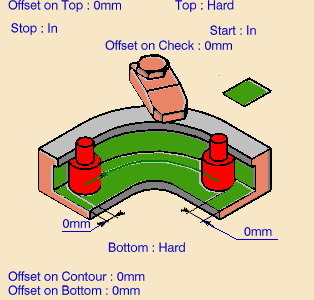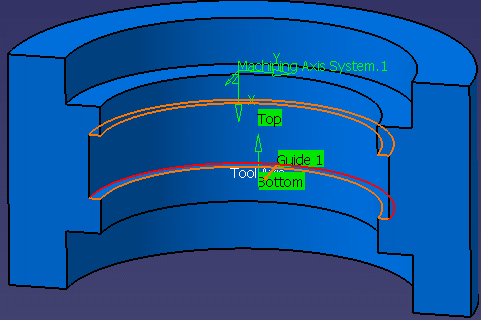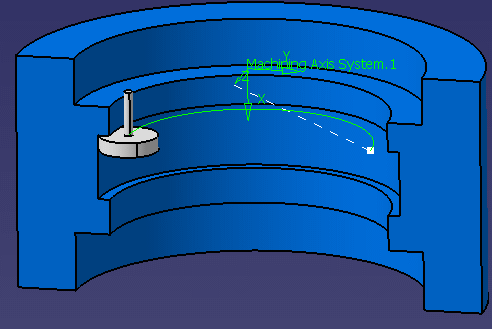 |
This task shows how to insert a
Groove Milling operation in the program. To
create the operation you must define:
- the tool that will be used

|
 |
Open the
sample_groove_milling.CATPart document, then select the desired
Machining workbench from the Start menu. Make the
Manufacturing Program current in the specification tree. |
 |
1. |
Select
Groove Milling
 . The Groove
Milling dialog box appears directly at the Geometry tab
page . The Groove
Milling dialog box appears directly at the Geometry tab
page
 . This page
includes a sensitive icon to help you specify the geometry to be machined. . This page
includes a sensitive icon to help you specify the geometry to be machined.
 |
 |
|
The groove top, bottom and flank in the icon are colored
red indicating that this geometry is required for defining the operation.
All other geometry is optional. Note that Contour Detection
contextual command is not activated. |
|
2. |
Click the red bottom in the icon, then select the bottom
of the groove in the 3D window. |
|
3. |
Click the red top in the icon, then select the top of the
groove in the 3D window. |
|
4. |
Click the red guiding element in the icon, then select the
flank contour of the groove in the 3D window. |
 |
|
If the Contour Detection contextual
command is set, the boundary of the selected face will be proposed
automatically as guiding contour. See
Specifying Guiding Contours for more information. |
|
5. |
Right click Start to set this condition to Out. Click the
first relimiting element in the icon, then select the horizontal edge at
one end of the contour profile in the 3D window.
Set the Offset on Limit1 to 5mm. |
|
6. |
Right click Stop to set this condition to Out. Click the
second relimiting element in the icon, then select the horizontal edge at
the other end of the contour profile in the 3D window.
Set the Offset on Limit2 to 5mm.See
Specifying Relimiting Elements
for more information. |
 |
|
The bottom, guide, limit and check elements of the icon
are now colored green indicating that this geometry is now defined. These
are also indicated on the part. |
|
|

|
|
7. |
Select the Strategy tab page
 and choose the
desired tool path style. You can then use the tabs to set parameters for: and choose the
desired tool path style. You can then use the tabs to set parameters for:
|
|
8. |
A tool is proposed by default when you want to create a machining
operation. If the proposed tool is not suitable, just select the
Tool tab page
 to specify the
tool you want to use. to specify the
tool you want to use.
This is described in
Edit the Tool of an Operation. |
|
9. |
Select the Feeds and Speeds tab page
 to specify the
feedrates and spindle speeds for the
operation. to specify the
feedrates and spindle speeds for the
operation. |
|
10. |
Check the validity of the operation by
replaying the tool path. |
| |
|
 |
| |
|
 |
 |
|
The specified operation uses a default Return between
levels macro to allow switching compensation points for machining upper and
lower levels of the groove. You can optimize this macro and add approach
and retract macros to the operation in the Macros tab
page  . This is
described in
Define Macros of a Milling Operation. . This is
described in
Define Macros of a Milling Operation. |
|
11. |
Click OK to create the operation. |
 |
|
A Collision Checking capability is available in the
Geometry tab page, which allows collision checking between the tool and
guide elements during macro motions. See
Reference section for more
information. |
|
 |









![]() . This is
described in
Define Macros of a Milling Operation.
. This is
described in
Define Macros of a Milling Operation.![]()